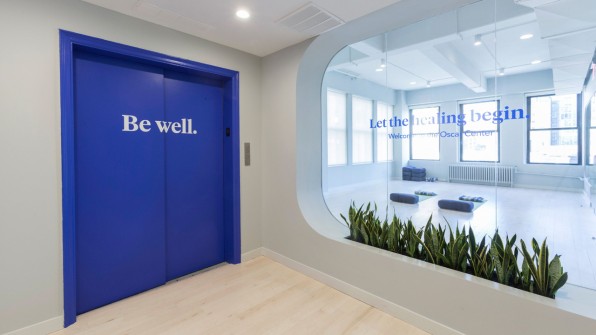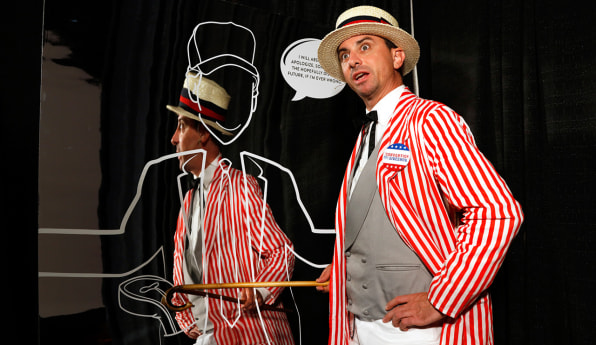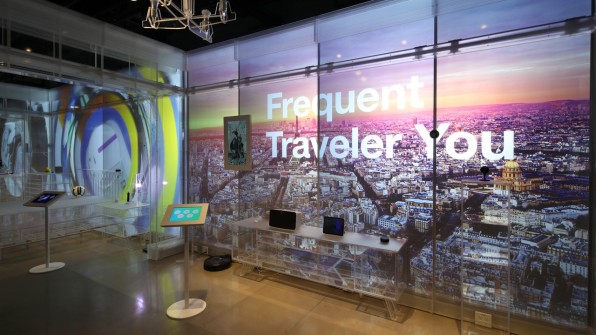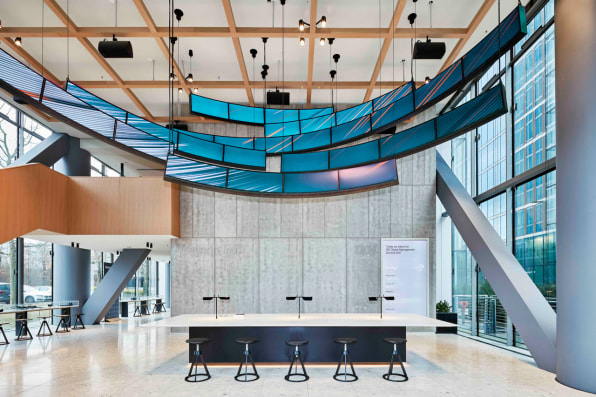What Channel Is Just for Laughs Gags on
When companies try to create "branded" experiences for their consumers, the results can be seriously cringeworthy. Anyone who's ever stepped inside a company's corny, hashtag-laden "activation" knows that's not the way to make your brand more meaningful.
So what's the secret to designing spaces that are actually useful and interesting to people, while remaining true to the brand? We asked honorees in the Branded Environments category of our 2017 Innovation By Design awards. These firmshave managed to create branded experiences that don't just successfully avoid annoyingly overt messaging and bad hashtags–they're downright beautiful and impactful. Here's their advice.

Don't just slap your name and logo on something
Liz Robau, product and tech communications manager at Oscar
"One of the things that people associate with our brand is really good design and tech.In designing the Oscar Center, we took the same ideas around simplifying healthcare into physical space. It's not just about putting your name and logo on things. It's an extension of Oscar's tech product brought into a real physical environment–to extend the same principles that you're using in your digital brand, whatever kind of relationship you're building with your end user, and try to extend those same principles to a more physical space.
"It's not just about you're sick, you need to go to the doctor, but we're trying to see, how do we make it a real tangible experience for people who aren't dealing with a chronic experience. You have them come to this place where they can get their checkup and there's also these wellness activities they can do there.It's a way of treating a whole member regardless of what their health status is. If there's a better word than wellness, that's what it would mean, this holistic view of your health."

Be entertaining and authentic
Matt Lower, managing director, Sub Rosa
"A branded environment needs to be more than a one-way brand dialogue. Think about it this way . . . if you had a friend who only ever talked about his or herself, you wouldn't want to speak to them very often, would you? In creating The Daily Show Convention Sideshow, we knew that rather than focus on The Daily Show as the primary content source, we needed to look at key moments in the 2016 campaign (little did we know how tame the political sideshow was at the time) to create an engrossing–and more importantly entertaining –environment that would encapsulate the circus that was U.S. politics at that moment in time.
"Draw from an authentically contextual world the audience can relate to. It must be authentic (and not just the buzzword definition of the word). Consumers are savvy and in order to be successful marketers, we must always assume the most of our potential audience. In The Daily Show Convention Sideshow , we sought to be equal-opportunity offenders, regardless of the fact that the client was Comedy Central and that the activation took place near the Republican National Convention in Cleveland. We understood that attendees were of all political persuasions and ultimately wanted to be united by one thing: comedy.
"Finally, make it fun. Our team, along with our clients at Comedy Central, sought to create a memorable, viral, shareable experience in The Daily Show Convention Sideshow . The key ingredient to achieving this end is to infuse joy into your work from the onset. People relate to joy; they connect to joy."

Think of your brand as a verb
Jake Barton, principal and founder, Local Projects
"If the brand is not colors and fonts but how it makes you feel and what it allows you to do, then the goal of a branded environment isn't just to be a 3D design exercise, it's here to invite your customers or your guests to achieve something extraordinary–hopefully through your brand. That is where loyalty and connection gets really extended, and that's why it's a good investment for companies.
"If you think about it, people can buy stuff in so many channels now, so why go to Target?We were tasked with understanding what the internet of things could allow customers to do in their daily lives. The promise we saw in the home space–it gives your home superpowers. We designed Open House as both a store and a laboratory. Target is so effectively optimized within its own stores that it's actually a bit of a challenge for them to innovate within specific stores. It allowed them to have a whole lab to experiment with IoT products that might not do so well within the existing ecosystem of their stores.
"It's not just a store or a lab, it's a platform for Target to experience new businesses, products, technologies for selling, and new design approaches for the entire brand. From a brand standpoint, Target has great interest in exploring and in demonstrating that it's interested in innovation and capable of innovation. You can put out a press release, you can buy a big billboard, you make a better logo. Or you can build a lab that is also a store that is also a platform for innovation, and embody, demonstrate, and actualize innovation.
"It's the difference between nouns and verbs. Brands in the past have all been nouns. We're blue, we're red, we're round, we're square. Now, certainly the way Local Projects thinks about brands, you're verbs. What do you do? If you want to be an innovative brand, don't make a logo, don't write something, actually make something that is innovative and demonstrates and forwards innovation, internally for you as a company."

The quality of the space reveals the quality of the brand
Jon Marshall, design director, MAP Project Office
"My personal opinion is when you go into spaces where the brand is thrust at you, you become a bit sick of it and immune to it, so the message gets lost. When you do it more subtly and you have to seek it out, a visitor to the space it has a longer lasting impression.
"The project was actually to design a specific floor in the headquarters, for IBM Watson IoT, to demonstrate what the product can do. IBM has such a long history and we were trying to capture the IBM of right now, not rely on IBM's history.
"For it not to be cringeworthy, we ended up not using too much branding and instead tried to capture the spirit of the brand through the materials and through things like the lighting and the technology that's used. The building itself, in the pure quality of material, gives you the quality of the brand. In the reception area, we used a lot of modern premium materials. We had an interactive art piece in the reception that communicated some of the value of the brand. Without using too much text or the logo, we were able to communicate that it was a branded environment."

Design for impact–which means no free samples
Andy Reynolds, Hong Kong creative director, Brand Union
"There are so many ways to answer this question, and most are intertwined with the brand you're creating it for. But overall, I'd say you don't always have to use the 'brand' to build a branded environment. By this I mean, you don't need to simply sell products with fancy visuals in trendy pop-ups. It's more impactful to show people what the brand is about through a relevant experience.
"For a recent project with Amnesty International in Hong Kong, we created a branded environment that reflected Amnesty's purpose. In this instance, we used the 2016 closure of bookshops and threat to Hong Kong's Article 27 protecting freedom of the press to spread the word that Amnesty is a champion for freedom of expression. We did this by opening a bookstore of our own and selling redacted books for HK$27. The Amnesty branding was subtle, but the experience was still impactful because of the environment's greater purpose and the empathy it engendered toward Amnesty's cause.
"I think the reasons why and how it happened are the same as to why it was successful. It was a timely, relevant, and emotionally powerful idea that resonated with people. Once we articulated the concept and made a plan, finding the right resources was relatively easy. People were eager to get behind the cause because they understood it and believed it was important.
"So, avoid giving away free samples of shampoo and coffee. Focus on making something that reflects what your brand stands for—its purpose—and your audience will engage."
What Channel Is Just for Laughs Gags on
Source: https://www.fastcompany.com/90144600/how-to-design-branded-environments-that-dont-make-people-gag